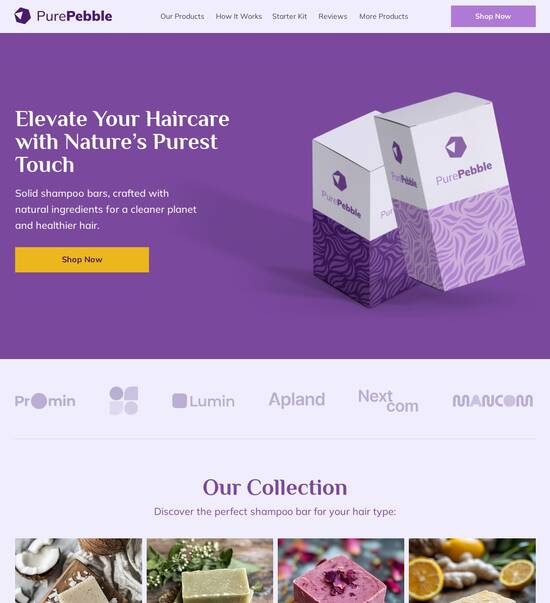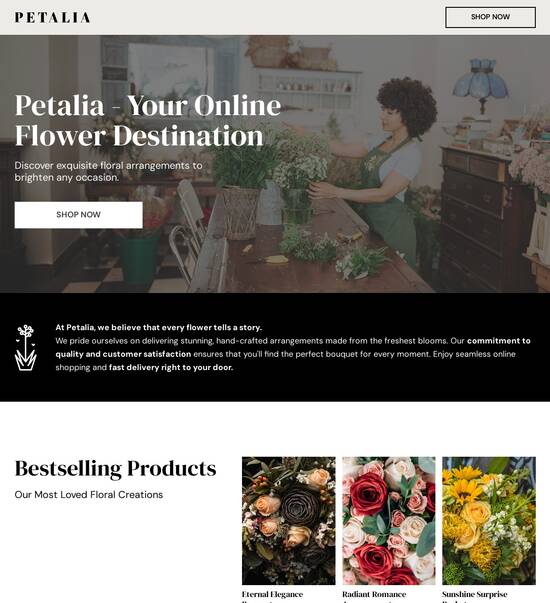
Website Template for Equity Analysts
Explore Similar TemplatesAbout template
Create customized landing pages quickly with 500+ conversion-focused layouts, A/B testing, heatmaps, and dynamic content personalization. No coding required.
Recommended templates

Easy to build without coding
With the intuitive drag-and-drop builder, anyone on your team can create high-converting pages without any knowledge of code or design. Make enhancements to your landing page with custom widgets using Javascript, HTML/CSS, or third-party scripts.

Multiple layouts for any industry and goal
Select from 500+ landing page layouts built to boost conversions across industry-specific scenarios. Customize them by adjusting fonts, adding images, and generating on-brand content with the AI assistant. Quickly scale with Instablocks® and Global Blocks that you can save, reuse, and update globally.

Loads fast and looks polished on any device
Every template is responsive, which means they present professionally on any device and load blazingly fast with our Thor Render Engine. You can also power them up with Google AMP technology to deliver an unparalleled mobile experience and drive higher conversions.

Robust analytics & experimentation
Get real-time updates and reporting across all your devices, showing the number of visitors, conversions, cost-per-visitor, and cost-per-lead. Launch AI-powered experiments, run A/B tests, and use heatmaps to analyze user behavior, then optimize your landing page to maximize conversions.







Easy to build without coding
With the intuitive drag-and-drop builder, anyone on your team can create high-converting pages without any knowledge of code or design. Make enhancements to your landing page with custom widgets using Javascript, HTML/CSS, or third-party scripts.
Multiple layouts for any industry and goal
Select from 500+ landing page layouts built to boost conversions across industry-specific scenarios. Customize them by adjusting fonts, adding images, and generating on-brand content with the AI assistant. Quickly scale with Instablocks® and Global Blocks that you can save, reuse, and update globally.
Loads fast and looks polished on any device
Every template is responsive, which means they present professionally on any device and load blazingly fast with our Thor Render Engine.
Robust analytics & experimentation
Get real-time updates and reporting across all your devices, showing the number of visitors, conversions, cost-per-visitor, and cost-per-lead. Launch AI-powered experiments, run A/B tests, and use heatmaps to analyze user behavior, then optimize your landing page to maximize conversions.
All the features you need to build lead-generating landing pages
Explore more featuresLearn how to build top-performing landing pages for any goal
FAQs
Leading the way in building high-performing landing pages





A comprehensive guide to optimizing conversions with Instapage
Instapage streamlines the process of creating high-converting landing pages that accelerate your marketing campaigns. With is all-in-one platform, marketers can amplify their ROI through optimized digital strategies tailored to their specific industry needs, whether in business services, financial services, or tech.
Understanding the power of Instapage for landing pages
Instapage offers over 100 customizable templates designed for conversion. These templates not only save time but also help team members focus on design effectiveness without needing technical skills. Users can leverage tools like Instablocks to create sections that can be reused across different pages, ensuring consistent branding and messaging.
- Diverse template selection: Choose from high-converting designs that suit various industries and marketing goals.
- No coding required: Easily build and edit pages using the intuitive drag-and-drop builder, enabling quick adjustments on the fly.
- Lead generation features: Use built-in forms and integrations to capture leads effectively without needing additional software.
Steps to optimize your landing pages with Instapage
Optimizing landing pages for higher conversions involves several key steps that leverage Instapage’s capabilities.
- Utilize A/B testing: Quickly create variations of your landing pages and measure their performance.
- Incorporate detailed analytics: Track visitor behavior and conversion metrics through Instapage’s analytics dashboard to fine-tune efforts accordingly.
- Implement personalization: Use dynamic text replacement to tailor messages based on the source of your traffic, enhancing user experience.
Enhancing collaboration in your marketing team
As team dynamics evolve, enabling real-time collaboration becomes essential. Instapage offers features designed to enhance teamwork.
- Real-time feedback: Allow team members to provide instant feedback on page drafts, creating a streamlined review process.
- Secure sharing options: Safely share access with external stakeholders while maintaining control over the design process.
- Version history: Keep track of changes and restore previous versions if necessary, ensuring no ideas are lost.
In conclusion, Instapage equips marketers with essential tools to create, optimize, and personalize landing pages, supporting effective digital marketing strategies.
Ready to elevate your campaigns? With Instapage, you can build stunning landing pages that genuinely resonate with your target audience.
People also ask about Website template for Equity analysts
Website templates for equity analysts: Enhancing reporting efficiency
Understanding the role of website templates for equity analysts
Equity analysts play a crucial role in the financial sector by providing insights into stocks and other securities. A key aspect of their work involves creating comprehensive equity research reports that guide investment decisions. Therefore, website templates designed specifically for equity analysts can greatly improve the efficiency and quality of these reports.
These templates are advantageous because they can enhance the clarity and structure of reports, allowing critical information to be presented in a way that is easily digestible. By utilizing standardized formats, equity analysts can focus more on analysis and insights rather than the mechanics of report creation.
Demystifying equity research reports
Equity research reports serve the purpose of summarizing an analyst's evaluation of a company. They typically provide in-depth analysis, forecasts, and recommendations, forming the backbone of investment research. The information within these reports is pivotal, influencing whether institutional and individual investors choose to buy, hold, or sell a stock.
Common elements include an executive summary, company overview, financial analysis, valuation, and risk assessment. This structure ensures all relevant details are covered, allowing stakeholders to make informed decisions.
Executive summary: A brief synopsis of the report’s main findings.
Company overview: General information about the business and its operations.
Financial analysis: Examination of the company's financial performance.
Valuation: Assessment of the company's current value using various methods.
Risk assessment: Identification of potential risks associated with the investment.
Efficient layout design for enhanced readability
The layout of equity research reports significantly affects their readability and effectiveness. A user-friendly experience is paramount in retaining the attention of stakeholders. Templates should emphasize clarity through clean, intuitive user interfaces that facilitate easy navigation and understanding.
When designing templates, certain layout considerations should be prioritized. These include the logical arrangement of sections, use of whitespace to reduce clutter, and appropriate font choices. Additionally, incorporating visual hierarchy allows readers to identify key information quickly, thereby enhancing the overall user experience.
Use of headings and subheadings to segment information.
Incorporation of bullet points to break down complex information.
Structuring the report to follow a logical flow of information.
Employing contrasting colors for headings to increase visibility.
Comprehensive data population features
A crucial aspect of equity research reporting is managing data effectively. Templates that automate data input can not only enhance accuracy but also save valuable time for analysts. By leveraging preset fields, analysts can focus on analysis rather than input, resulting in more efficient report drafting.
Dynamic content blocks are another essential feature. By allowing templates to pull in real-time data updates, analysts stay informed of the latest market movements or company developments without having to manually refresh their reports. Furthermore, integrating external databases ensures that reports benefit from comprehensive datasets, thereby deepening the analysis and insights captured.
Set up automated input systems for routine data.
Utilize dynamic blocks for constant data updates and relevancy.
Connect external sources for enriched contextual analysis.
Template customization: Tailoring to specific needs
The ability to customize templates is vital for equity analysts as they cater to different sectors and investment styles. Industry-specific design considerations ensure that reports contain relevant metrics, conform to sector norms, and appeal to their target audience. Adjusting aesthetics can greatly aid in aligning reports with user preferences, making the data more relatable.
Moreover, incorporating company branding into templates strengthens professional presentation. Analysts can showcase their firms distinctly while maintaining consistency in presentation across reports, fostering expertise and professionalism.
Develop sector-centric templates that highlight key performance indicators.
Allow customizable color schemes and logos for brand alignment.
Provide options for including industry jargon and visuals suited to the audience.
Advanced features for sector reports
Sector-specific templates are essential for providing focused analyses that cater to unique characteristics and needs in various industries. Each sector has its own set of metrics and performance indicators that analysts must consider. For example, analysts in the tech sector may prioritize different data points than those in the energy sector.
These specialized templates can also include comparative analyses with competitors within the same sector. By enabling side-by-side comparisons, analysts can paint a more comprehensive picture for their audience. Incorporating sector-focused templates streamlines the reporting process, allowing for quicker preparation without sacrificing detail.
Identify key metrics unique to specific sectors.
Incorporate visuals that simplify comparisons within sector reports.
Offer templates designed for specific industry analyses.
Integration of robust tables and data visualization tools
Effectively presenting data is paramount for equity analysts, particularly when discussing peer group comparisons or performance metrics. Well-structured tables allow analysts to succinctly present complex information, making it readily digestible for readers. The design of tables should prioritize clarity, with properly labeled columns and consistent formatting to enhance understanding.
In addition to tables, data visualization tools are critical for transforming numbers into insights. Charts and graphics can illustrate trends and comparisons that might be less apparent in raw data form. Utilizing these tools also caters to different learning styles, engaging visual learners effectively and enhancing report comprehension.
Incorporate interactive tables that allow users to sort and filter data.
Utilize graphs that visually represent data trends over time.
Follow best practices for data visualization to avoid misinterpretation.
Peer group data and its role in report preparation
Understanding peer groups is crucial for equity analysts as these groups serve as benchmarks for investment analysis. Defining peer groups allows analysts to gauge a company’s performance relative to its competitors, informing investment recommendations. It’s vital for reports to clearly outline these peer comparisons, thus providing additional context for analyses.
Gathering peer group data can involve various methods, from industry analysis to utilizing databases that provide market overviews. Presenting this data in an easy-to-understand manner furthers the report’s utility. Employing comparative analysis techniques facilitates deeper insights, highlighting strengths and weaknesses both quantitatively and qualitatively.
Select appropriate peer companies for meaningful comparisons.
Utilize graphs to depict relative performance metrics of peers.
Apply benchmarking methods to establish context in reports.
Share price information and interactive reporting
Incorporating share price information into equity research reports is essential for providing real-time insights. Analysts should use reliable sources for live share price feeds to ensure accuracy. Incorporating this data allows analysts to present an up-to-date view of a company’s performance, which is crucial for making timely investment recommendations.
Adding interactive elements can further enhance user engagement. Features such as drop-down menus for selecting different time frames or visualizations of share price movements enable users to interact with the data. Additionally, setting alerts for price changes or significant market movements ensures that stakeholders remain informed and engaged, allowing them to respond promptly to market fluctuations.
Integrate API feeds for current share price updates.
Design interactive charts that allow users to explore share price trends.
Provide options for alert settings based on market movement criteria.
Template flexibility and scalability for diverse companies
The scalability of report templates is fundamental in adapting to the varying needs of companies. Small cap and large cap firms often require significantly different report formats that cater to their unique audiences and reporting standards. Flexibility within templates ensures that analysts can tailor the depth and breadth of the report based on the company size and market presence.
By utilizing modular template approaches, firms can customize report sizes according to client needs, further enhancing the analytical process. Flexibility in templates is essential for meeting the evolving needs of the market, ensuring that equity analysts remain compliant with sector-specific standards without sacrificing efficiency.
Assess template usability across different company sizes.
Implement modular templates that can expand or contract based on needs.
Showcase real-life examples of successful template flexibility in practice.
Structured approach to report creation
Establishing a consistent template framework is vital for effective report creation. Essential sections, such as an executive summary, market overview, and risk assessment, should be included in all equity research reports. Maintaining a structured format promotes consistency, improves reader familiarity, and allows analysts to ensure that no critical information is overlooked.
Setting suggested timelines for report preparation and updates further enhances the productivity of equity analysts. By adhering to predetermined timelines, teams can manage their workload efficiently and enable strategic planning, allowing for quick adaptations as new information becomes available.
Outline essential sections needed in every equity research report.
Develop timelines for report preparation to streamline processes.
Encourage regular updates to maintain the relevance of the reports.
User experience: Navigating the interface
A seamless user experience is crucial when utilizing website templates for generating equity research reports. Understanding interface features tailored for equity analysts will enable users to maximize their effectiveness. A well-structured setup should guide users through the report creation process, from input data to final output seamlessly.
Simplifying navigation involves creating intuitive workflows and ensuring user-friendly features. Gathering user feedback routinely is essential for continually improving the template experience, enabling designers to identify common pain points and enhance usability for future iterations.
Create tutorial aids for new users to navigate templates quickly.
Implement feedback mechanisms to gather user suggestions.
Continuously refine the interface for improved user engagement.
The transformative impact of templates on analytical reporting
The implementation of templates has transformed the way equity analysts prepare reports. Several firms have reported measurable improvements in both report creation time and accuracy since utilizing standardized templates. This efficiency not only reduces costs but also enables analysts to dedicate more time to thorough analysis instead of formatting and organizing data.
Testimonials from industry professionals frequently highlight the reduction in reporting time and the increase in report reliability. By leveraging templates tailored for equity research, analysts find their output not only meets but exceeds client expectations, contributing to overall enhanced investment outcomes.
Document case studies of firms improving report efficiency.
Collect analyst testimonials regarding template benefits.
Analyze productivity shifts pre- and post-implementation of templates.
Future trends in equity research reporting tools
The landscape of equity research reporting tools is continually evolving, driven by technological innovations. Emerging tools that incorporate artificial intelligence and machine learning promises to revolutionize data population methods, streamlining the analysis process and enhancing predictive capabilities for analysts.
Predicting shifts in reporting templates suggests a move towards even more personalized and adaptable solutions that cater to individual analyst needs. Continuous advancements in technology will allow for richer data integration and improved user experiences.
Follow advancements in AI for data analysis and reporting.
Anticipate changes in user demand for template personalization.
Monitor technology trends influencing the equity research landscape.
Final thoughts on enhancing efficiency with templates
In summary, adopting tailored templates for equity analysts brings several advantages that elevate the quality of reports and improve operational efficiency. By harnessing the power of templates, analysts can concentrate on delivering insightful analysis that can lead to better investment outcomes.
Proactively adapting to advanced template solutions reflects a commitment to continual improvement in professional practices. Embracing these tools not only supports analysts in enhancing their workflows but also fosters a culture of excellence in the financial services sector.
Highlight the advantages of structured template systems.
Emphasize the connection between templates and improved decision-making.
Encourage ongoing exploration of template innovations in equity research.
Ready to skyrocket conversions?
Supercharge your ad campaigns with high-performing landing pages
Get started














